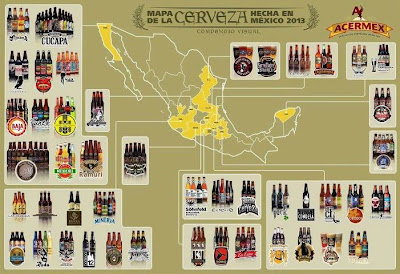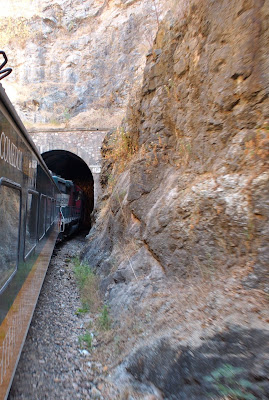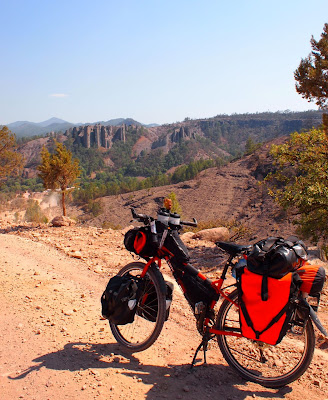We set out from Ciudad Constitución with a good tailwind but it was clear that our days of traffic-free cycling were over. Not only did our four-lane highway go back to two lanes, but drivers were a bit more aggressive on this stretch of road requiring constant vigilance with our
mirrors. However, the flat farmland turned into some nice rolling hills. We even saw a young guy geared out in spandex training... with his mother following closely behind in a car to ensure his safety. He seemed a bit embarrassed and kinda grunted at us as he passed by, while his mother gave us a friendly wave.
After cycling about 120 km, we ended up scooting under the fence into the desert and camped near the marker for Km 89. We stopped at the one little restaurant between our campsite and the outskirts of La Paz and met a wonderful duo of motorcyclists from La Paz, in particular, the affable and exuberant Jorge... a 78-year old dynamo who is still living life to the fullest. He himself is also a cyclist and was fascinated by our journey and our story. He checked out our gear, gave us his phone number, and offered us any and all assistance we could possibly need upon our arrival to La Paz.
La Paz was a wonderful surprise. It is urban and sophisticated because it is the capitol of Baja California Sur, but it still maintains a small-town feel with a warm sense of community and openness that is so rare in big cities. It also has a nice balance of national (that is, Mexican) tourists and international tourists, and you never feel like you're just wandering amongst other tourists. We spent a few days enjoying La Paz while we waited for some things we had ordered to arrive, pimped out spokes and hubs for Gonzalo and a
new helmet mirror and a
replacement Camelbak mouthpiece for me.
 |
| La Paz in the distance... it's a bit misleading, you feel like you are almost there, and then it's a long windy ride around the bay! |
 |
| We explored the malecón to see if we could find a cart that serves fresh clams for Gonzalo, but to no avail, the stand was closed already. However, I discovered a small bar called Harker Board Co. that serves real actual local craft beer! The brewmaster is from Colorado and they are based out of Los Cabos... my joy was apparent and I ended up having several pints of what is dubbed as the "hoppiest beer in Mexico." After over a month of watery light beer, I was in heaven. |
 |
| Some research reveals that cerveza artesanal is gaining some traction here in Mexico. I am excited to discover the local beers here!!! |
 |
| We had a gorgeous sunset from the "bar o' happy draft beer for LeeAnn" and then headed back to our hostel to crash out. After five straight days of cycling, we were exhausted. |
The next morning, we wandered into the local market for breakfast and lo and behold, Jorge found us! It turns out he had remembered we were staying in a
pensión and there are only two near the
malecón so he had stopped by to ask if any cyclists had arrived. He had the good sense to look for us at the market and we ended up spending the better part of the morning as his guests. Gonzalo's camera died on the road, so Jorge called around to see where would be the best place for Gonzalo to replace it, and then schlepped us around to every possible place so Gonzalo could see what was available. We stopped by Jorge's house for some iced tea and met his wife and daughter, and talked about living life coloring outside the lines. Jorge is also an adventurer, a retired Aeroméxico pilot who has traveled extensively himself. In fact, he cycled from Santa Rosalía to La Paz forty years ago. Now he bikes recreationally twice a week and goes on regular motorcycle rides with his friends.
Jorge dropped us back off at the hostel with an invitation to meet up later for coffee and drinks with some of his friends. We agreed we would be in touch and set out to satisfy Gonzalo's craving for fresh clams.
 |
| Gonzalo finally gets his fresh clams at the little stand located near the Hotel Pekin off the malecón. |
 |
| I tried a few pieces and they are amaaaazing. They are meaty and sweet and incredibly fresh. Nothing but a little lime, salt, and hot sauce. |
 |
| Sometimes the best places come in unassuming packages. This guy's stand was basically full the entire time we were there, it's less than half the price of the fancy beachfront restaurants and probably tastier (80 pesos bought Gonzalo over a dozen clams and a beer). The plump gentleman originally hails from Mazatlan (I think) and provided us some bawdy and lively conversation... it's clear he comes here often. |
 |
| The sunset on the malecón is stunning and different each night... this was our view as we pulled up with Jorge to meet his friends for coffee and drinks. |
 |
| Our motley crew... we spent several hours sharing travel stories until it was well past everyone's bedtimes. Jorge brought his excitable but very nice dog. |
The next day, Sara, the lovely woman from Guerrero Negro who adopted us during our time there, introduced me to Glenda Davila on Facebook. Glenda is the founder of a group called
Ellas en Bici, a women's cycling group here in La Paz, and made us feel right at home by inviting us to go kayaking and to attend a free jazz concert at the local cultural center. I had a few hours to myself before kayaking because Gonzalo was taking his daily mid-day nap, so I explored a bit and cobbled together a lunch from the nearby market complete with freshly made tortillas from the
tortillería.
 |
| La Paz has some fun funky artwork on its buildings. Reminds me a bit of the artwork we saw in Boise. |
 |
| I really liked the artwork on this gallery, too bad it was closed! |
Glenda came by the hostel with her friend Martha to pick us up to head down to the water. There, we met the queen of kayaking, Margarita, and we were off to explore an area where the blue herons go to sleep at sunset. Glenda, Martha, and Margarita often meet to paddle together, sometimes bringing dinner and drinks, sometimes in the rain, sometimes for a night paddle with a full moon, but always to catch up and reconnect. They are an easygoing and vivacious group and we ended up having so much fun on the water that we missed the concert!
 |
| Glenda, Martha, and Margarita head back to shore. |
Then, at long last, Martin, Eduardo's friend who did us the huge favor of receiving the spare parts for us, let us know the package had arrived. He invited us to lunch with his wife and grandson, which allowed them to catch up with Gonzalo, who they had welcomed the last time Gonzalo biked through Baja. We had a leisurely lunch and some nice conversation over
almejas chocolatas, an assortment of scallop and octopus tacos, and
micheladas. I decided to go watch the sunset and Glenda and her crew stopped by!
 |
| Martin, his lovely wife, and their grandson (photo credit: Gonzalo with his new camera)! |
 |
| Ellas en Bici stopped by to visit while I was enjoying one last craft beer in La Paz at Harker Board Co. |
I closed the night out chatting with the former counsel to Bill Gates who handled his original IPO (yea, yea, yea, we lawyers somehow always find each other) and some vagrant Canadians who live here. We talked about what we missed about the practice of law itself (not a whole lot other than the intellectual stimulation) and how we kept our brains active after leaving the law (he sits on a lot of board of directors). He thinks I would be great in academia and it would afford me a schedule that would accomodate a more liberal lifestyle.
A few travel notes for cyclists:
- We saw plenty of places to stop for supplies for the majority of this section, except between the marker for Km 89 and the outskirts of La Paz, we only found one little place around the marker for Km 35 or so.
- I enjoy Gonzalo's way of managing dogs that chase us. The first method is to just stop. They often get confused when you stop and lose interest. Gonzalo often then puts his hand out and pets them, and all of a sudden he has a new best friend. The second method is to slow down and chase the dog back. They realize "holy cow, this bike-beast is way bigger than I am" and run away.
- We are staying at the popular Pensión California, which is a well-established hostel in La Paz on Degollado at Revolución. It is very basic, but offers free wifi, a computer for use by guests, a basic kitchen, a nice communal area which is conducive to meeting other travelers, free drinking water, and is well-situated near the malecon, the market, and a popular taco stand. Because it is featured in the Lonely Planet, is popular even now in the low season. There is a new hostel in town called Baja Backpackers, but it is pricey for anyone traveling with a friend and the Pensión California is a much better deal. They appear to have a sister hostel for the high season with a similar name and similar facade just around the corner.
- The Pensión California is conveniently located near the market, which has its own tortillería (the flour tortillas were amazing fresh off the press) and cafeteria area for delicious and economical set meals. I highly recommend the fruit cart out front... a huuuuuge fruit salad costs about US$2.50 and you can choose whatever fruit you want in it. It's so big it's more than enough for breakfast with some leftover for a snack alter.


















































